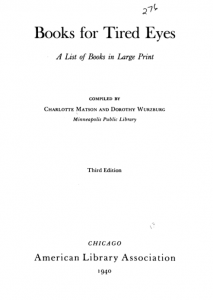Libraries around the world have progressively become more aware of the services they provide for users with disabilities. According to the ALA, they “recognize that people with disabilities are a large and neglected minority in the community and are severely underrepresented in the library profession.”[1]
After processing various publications done by the ALA from the record series 13/10/7, I came across a title that caught my attention. “Books for Tired Eyes” it read in big letters. Interested as to what this book was about, I started flipping through the pages only to find well known book titles listed throughout. As I continued being curious, I saw examples of different sizes of fonts. Finally, after an “ah-ha” moment, I realized that this book was a list of titles that were published in larger fonts for users that have visual impairments. The book was compiled by Charlotte Matson in 1931 and includes a list of books in 24 and 36 print type in categories such as adult fiction, adult nonfiction, and children’s books.

“Books for Tired Eyes” isn’t the only thing that the ALA and libraries are doing in order to serve patrons with disabilities. The ALA created the “ALA Library Services for People with Disabilities Policy” that pushes libraries to meet the needs of all people. ALA accredited Library and Information Schools educate students and staff on persons with disabilities through classes as well as presentations. For example, in 2015, the University of Illinois had Dr. Irmgarda Kasinskaite-Buddeberg presented information on the right to accessible information for persons with disabilities.

Accessibility is one of the most important aspects in both libraries and archives. It is important to remember that not all users are the same. The ALA has done, and is continuing to, remove physical and technical barriers to accessing library resources. What started as a book compiled of a list of titles in large fonts for the visually impaired in 1940, has turned in to screen readers to use in a library and other resources that accommodate people with disabilities. Thanks to the help and encouragement of the ALA, libraries are implementing new software, materials, and technologies to promote equal access for all users.
For more information on the American Library Association’s policies regarding libraries or services for people with disabilities, please refer to their website www.ala.org. The ALA Archives also contain information on policies, events, and publications that refer to disabilities and their policies at www.archives.library.illinois.edu/ala. Relevant record series include: 2/1/44, 23/2/6, and 23/3/12.
[1] The American Library Association, “Library Services for People with Disabilities Policy”, http://www.ala.org/ascla/asclaissues/libraryservices, accessed 3/31/2016.